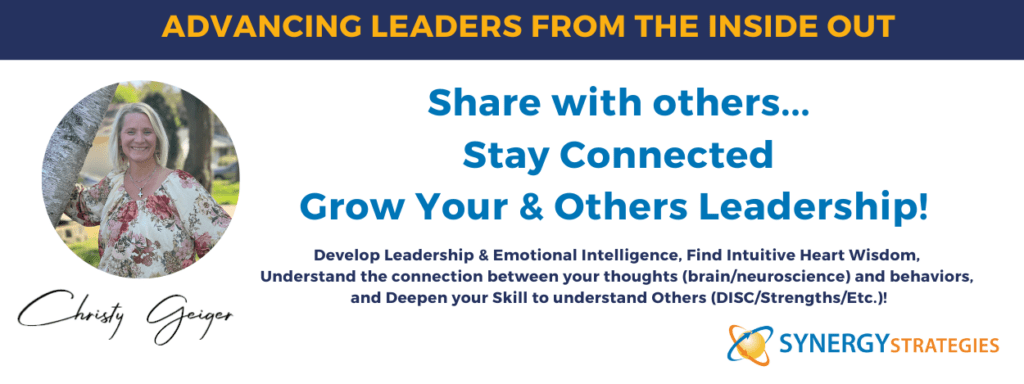As a leader, understanding and recognizing the common thinking traps that can hinder decision-making and overall leadership effectiveness is essential. The 12 thinking traps we’ll discuss are rooted in psychology and neuroscience and have been drawn from various fields such as cognitive psychology, emotional intelligence, and leadership research. Thought leaders such as Daniel Kahneman, author of “Thinking, Fast and Slow,” and Brené Brown, known for her work on vulnerability and leadership, have extensively contributed to the study of these thinking traps. These traps are widely recognized as common cognitive biases and irrational patterns of thinking that can impede decision-making and interpersonal dynamics. The work of influential researchers and authors such as Daniel Kahneman, Amos Tversky, and other behavioral economists has significantly contributed to our understanding of cognitive biases and thinking traps. While different variations and additional traps may exist, these 12 thinking traps are frequently referenced as the most prevalent and impactful patterns that leaders must navigate to achieve successful leadership.
As you review the 12 thinking traps consider:
- Which thinking traps do I find myself most frequently falling into?
- How do these thinking traps hinder my leadership effectiveness?
- What steps can I take to overcome these thinking traps and operate at a higher level?
12 Thinking Traps
- Always being right: This thinking trap occurs when a leader is unwilling to consider other perspectives or admit when they may be wrong. This can create a toxic work environment and hinder team collaboration. To overcome this, leaders should practice humility and actively seek out differing opinions and feedback.
- Example if trapped: A leader refuses to consider an alternative approach to a project because they believe their way is the only correct way.
- A healthier way to respond might be: “I appreciate your suggestion; let’s consider all options and decide on the best approach together.”
- Skills to develop to overcome this trap: Emotional intelligence, humility, open-mindedness, and effective communication skills are crucial. Developing empathy and active listening can also help in considering and appreciating others’ perspectives
- Action to consider:
- read “Emotional Intelligence 2.0” by Travis Bradberry or “Dare to Lead” by Brené Brown, and actively practicing empathy through activities such as volunteering and actively seeking feedback from team members.
- engage in empathy-building exercises, such as volunteering or participating in team-building activities, to practice considering others’ perspectives and seeking collaboration in decision-making.
- enroll in courses or workshops focused on conflict resolution and negotiation skills to learn effective ways of managing disagreements and finding common ground.
- Black and white thinking: Also known as binary thinking, this trap is characterized by the inability to see shades of grey and can lead to rigid and inflexible decision-making. Leaders should strive to adopt a growth mindset and consider multiple possibilities and options when faced with decisions.
- Example: A leader believes that if a team member makes a mistake, they are a failure and cannot be trusted with any future tasks.
- A healthier way to respond might be: “We all make mistakes; let’s identify how to support you and help you grow from this experience.”
- Skills to develop to overcome this trap: Developing a growth mindset, empathy, effective communication, patience, and openness to feedback are important. Recognizing the potential for growth and learning from mistakes is crucial.
- Action to consider:
- read “Mindset: The New Psychology of Success” by Carol S. Dweck and journaling about one’s own experiences of growth and learning, while actively seeking out diverse perspectives and considering alternative viewpoints.
- read “Thinking in Bets: Making Smarter Decisions When You Don’t Have All the Facts” by Annie Duke to understand the value of probabilistic thinking and the importance of considering multiple perspectives.
- practice active mentoring or coaching relationships to promote an environment of continuous learning and development rather than punishment for mistakes.
- Catastrophizing: This occurs when a leader magnifies the negative aspects of a situation, leading to unnecessary stress and anxiety. Instead, leaders should practice reframing and focus on finding solutions and opportunities in challenging situations.
- Example: A leader becomes overwhelmed with anxiety when a project encounters a minor setback, believing it will ultimately lead to complete failure.
- A healthier way to respond might be: “While this is a setback, it’s an opportunity for us to regroup, come up with a plan, and move forward.”
- Skills to develop to overcome this trap: Resilience, emotional regulation, problem-solving skills, and optimism can help turn a setback into an opportunity for growth. Effective stress management and the ability to refocus on solutions rather than dwelling excessively on problems can also be beneficial.
- Action to consider:
- read “The Resilience Factor” by Karen Reivich and Andrew Shatte, while practicing mindfulness and seeking out opportunities to reframe challenges as learning experiences through meditation or yoga.
- attend a stress reduction or resilience training workshop to learn strategies for managing anxious thoughts and emotions effectively.
- engage in cognitive behavioral therapy (CBT) exercises, such as thought challenging and reframing, to practice shifting catastrophic thoughts towards more realistic and manageable perspectives.
- Emotional reasoning: This trap occurs when a leader makes decisions based on their emotions rather than logic or reason. To overcome this, leaders should practice mindfulness and emotional intelligence, allowing them to make more balanced and rational decisions.
- Example: A leader decides not to pursue a partnership because they have a bad feeling about it, despite all evidence and data pointing towards its potential success.
- A healthier way to respond might be: “Let’s review the data and analyze the potential risks and benefits before making a decision.”
- Skills to develop to overcome this trap: Emotional intelligence, critical thinking, data analysis, and the ability to balance emotions with rational decision-making are crucial. Deepening self-awareness and understanding the impact of emotions on decision-making is important.
- Action to consider:
- read “The Emotional Intelligence Quick Book” by Travis Bradberry and Jean Greaves, while actively seeking to separate emotional responses from logical decision-making through meditation or cognitive behavioral therapy exercises.
- participate in mindfulness or emotional intelligence training to develop awareness of emotional triggers and practice responding to situations rationally.
- engage in stress reduction activities such as meditation, yoga, or deep-breathing exercises to enhance emotional regulation and reduce reliance on emotional reasoning.
- Fallacy of change: This trap occurs when a leader expects others to change to meet their expectations, rather than focusing on changing themselves. Instead, leaders should focus on personal growth and continuous improvement, leading by example rather than expecting change from others.
- Example: A leader expects their team to adapt to new processes without providing sufficient training or support, assuming that everyone should just be able to adjust on their own.
- A healthier way to respond might be: “Let’s ensure everyone has access to the resources they need to adjust to our new processes.”
- Skills to develop to overcome this trap: Effective change management skills, empathy, understanding of individual differences, and effective communication are crucial. Recognizing personal challenges and providing relevant support are important leadership abilities.
- Action to consider:
- read “Switch: How to Change Things When Change Is Hard” by Chip Heath and Dan Heath, while actively providing comprehensive training and support to team members undergoing change and considering personal experiences of change and development.
- attend change management workshops or seminars to gain insights into effective strategies for leading and managing organizational change.
- explore case studies or success stories of change initiatives to understand best practices and learn from real-world examples.
- Filtering: This trap occurs when a leader only focuses on the negative aspects of a situation, ignoring the positive elements. To overcome this, leaders should practice gratitude and mindfulness, actively seeking out and acknowledging positive aspects of their work and team.
- Example: A leader focuses only on one negative comment in a performance review, ignoring all the positive feedback that was also provided.
- A healthier way to respond might be: “I appreciate your feedback, I will make sure to consider both positive and negative aspects in the future.”
- Skills to develop to overcome this trap: Gratitude, mindfulness, and the ability to shift focus from negative to positive aspects are important. Effective feedback reception and acknowledgment of strengths alongside areas for improvement are crucial communication skills.
- Action to consider:
- read “The Power of Positive Thinking” by Norman Vincent Peale and practice daily gratitude journaling, focusing on acknowledging and expressing gratitude for positive aspects of the day.
- practice daily affirmations or gratitude exercises to reframe attention towards positive aspects and practice acknowledging strengths and accomplishments.
- seek out constructive feedback channels and actively encourage open dialogue in the workplace for a balanced view of performance.
- Fortune telling: This occurs when a leader predicts the future based on little or no evidence, leading to unnecessary anxiety and stress. Leaders should focus on data-driven decision-making, basing their predictions on factual information rather than assumptions.
- Example: A leader believes a project will fail before it even starts, based solely on their pessimistic predictions rather than actual insights or analysis.
- A healthier way to respond might be: “Let’s gather all the information and consider different scenarios before making a judgment.”
- Skills to develop to overcome this trap: Critical thinking, data analysis, managing uncertainties, and a solutions-focused approach are crucial. Effective scenario planning, risk analysis, and open-mindedness can help counteract pessimistic predictions.
- Action to consider:
- read “Thinking, Fast and Slow” by Daniel Kahneman and actively seek out and analyze multiple potential outcomes for a situation before making a judgment.
- engage in scenario planning exercises, such as “what-if” analyses, to practice assessing and preparing for different potential outcomes in decision-making.
- seek out opportunities to engage in strategic planning and gain firsthand experience in understanding uncertainties and managing risks.
- Jumping to conclusions: This trap occurs when a leader makes assumptions without gathering all the necessary information. To overcome this, leaders should practice active listening and seek out diverse perspectives before making decisions.
- Example: A leader assumes a team member isn’t working hard enough without understanding the additional personal challenges they may be facing outside of work.
- A healthier way to respond might be: “I’d like to have an open conversation with you to understand your challenges and see how we can support you.”
- Skills to develop to overcome this trap: Active listening, empathy, openness to diverse perspectives, and the ability to suspend judgment are crucial. Effective communication and the willingness to seek additional information and feedback are important skills.
- Action to consider:
- **read “Crucial Conversations: Tools for Talking When Stakes Are High” by Al Switzler and Joseph Grenny, while actively listening and seeking out diverse perspectives in discussions and decision-making.
- seek out professional development opportunities in active listening and communication to practice understanding diverse perspectives before forming judgments.
- participate in improvisation or debate workshops to enhance the ability to think critically and consider multiple viewpoints in real time.
- Mind reading: This trap occurs when a leader assumes they know what others are thinking without any evidence. To overcome this, leaders should practice open and transparent communication, actively seeking out feedback and input from their team.
- Example: A leader assumes a team member disagrees with a decision, without actually discussing or understanding their perspective.
- A healthier way to respond might be: “I’d like to hear your thoughts on the matter; it’s important to consider everyone’s input.”
- Skills to develop to overcome this trap: Open and transparent communication, active listening, and empathy are vital. Providing an environment for open dialogue and encouraging diverse opinions can help to prevent assumptions about others’ thoughts.
- Action to consider:
- read “Nonviolent Communication: A Language of Life” by Marshall B. Rosenberg and actively seeking open and transparent communication with team members to understand their thoughts and perspectives.
- participate in a course or workshop on active listening skills to improve understanding and empathy.
- engage in regular one-on-one check-ins with team members to practice open and transparent communication and actively seek their feedback and perspectives.
- Overgeneralizing: This occurs when a leader applies a single negative experience to their entire outlook on a situation or person. To overcome this, leaders should practice empathy and seek to understand the broader context of a situation before making judgments.
- Example: A leader has a negative interaction with a single customer and subsequently decides that the entire customer base is dissatisfied.
- A healthier way to respond might be: “Let’s gather more feedback and data to have a full understanding of our customer base before drawing conclusions.”
- Skills to develop to overcome this trap: Data analysis, critical thinking, empathy, and the ability to challenge assumptions play a crucial role. Seeking out diverse perspectives and avoiding premature judgments are vital leadership skills.
- Action to consider:
- read “Conversational Intelligence” by Judith Glasser to learn a “we” approach, creating more curiosity and seeking to understand rather than drawing quick conclusions.
- attend a workshop on data analysis and statistical reasoning to strengthen the ability to interpret and evaluate information critically.
- seek feedback from diverse sources or seek out mentorship to gain different perspectives on situations rather than relying solely on personal experiences.
- Personalization: This trap occurs when a leader takes responsibility for events that are beyond their control, leading to unnecessary guilt and stress. Leaders should practice self-compassion and recognize that not everything is within their control.
- Example: When a team member resigns, a leader blames themselves for the departure, assuming that they must be a bad leader.
- A healthier way to respond might be: “It’s important to acknowledge that everyone has their own reasons for their choices, and we’ll find a way forward.”
- Skills to develop to overcome this trap: Self-compassion, humility, and avoiding self-blame are important. Effective stress management, support-seeking behavior, and avoiding overly self-critical thoughts are important for emotional resilience.
- Action to consider:
- read “The Gifts of Imperfection” by Brené Brown and actively practicing self-compassion through journaling, self-affirmation, and reframing self-critical thoughts to better understand the importance of embracing imperfection and self-compassion.
- check out “Self-Compassion: The Proven Power of Being Kind to Yourself” by Kristin Neff. This book offers practical guidance on developing self-compassion and understanding how to overcome self-blame and unrealistic self-criticism. Through exercises and examples, Neff’s work can assist individuals in cultivating a greater sense of self-kindness and understanding, ultimately supporting leaders in overcoming the personalization thinking trap.
- engage in self-reflection and journaling to identify and challenge patterns of self-blame and practice self-compassion in difficult situations.
- Should statements: This trap occurs when a leader imposes unrealistic expectations on themselves and others, leading to unnecessary pressure and stress. Instead, leaders should focus on setting realistic goals and fostering a growth-oriented environment.
- Example: A leader continually tells themselves they should be able to handle all their responsibilities without needing any help, leading to excessive stress and pressure.
- A healthier way to respond might be: “It’s okay to ask for help when needed; let’s look for ways to lighten the workload and support each other.”
- Skills to develop to overcome this trap: Effective stress management, delegation skills, and the ability to seek support when needed are important. Promoting a culture of open communication and support-seeking behavior can reduce self-imposed pressure.
- Action to consider:
- read “The Mayo Clinic Handbook for Happiness” by Amit Sood and actively seek emotional support from colleagues, mentors, or professional counselors to alleviate self-imposed pressure.
- patriciate in stress management programs to learn effective coping mechanisms and techniques for managing self-imposed pressure.
- engage in assertiveness training or seek out public speaking opportunities to practice healthily expressing personal needs and boundaries.
To operate at a higher level as a leader, it’s important to reflect on these thinking traps and consider which ones may be most challenging for you.
Reflect on the following questions:
- How have these thinking traps manifested in my leadership experiences, and what have been the potential consequences?
- In what ways might recognizing and overcoming these thinking traps enhance my decision-making and overall leadership effectiveness?
- How can I proactively develop the emotional, communication, and leadership skills necessary to overcome these thinking traps, and what initial steps can I take to put this development into action?
By recognizing and actively working to overcome these thinking traps, leaders can significantly enhance their decision-making process and promote a positive work environment conducive to growth and collaboration. Prioritizing the development of emotional intelligence, effective communication, and adaptive leadership skills is crucial to navigating and mitigating these traps, enabling leaders to respond with greater clarity and resilience. Upon identifying the thinking trap that poses the greatest challenge, leaders should consider specific skill-building opportunities and take targeted actions to foster growth in that area. Engaging in purposeful actions and leveraging alternative strategies can empower leaders to effectively overcome these cognitive biases, ultimately enhancing their leadership effectiveness and guiding their teams toward success.
It is important “work” and it WILL impact your leadership and those around you in a powerful and positive way!






